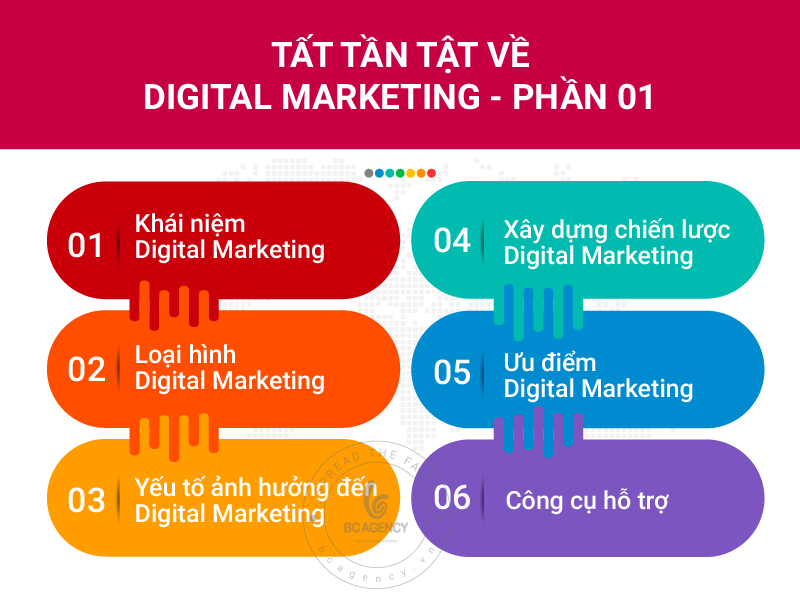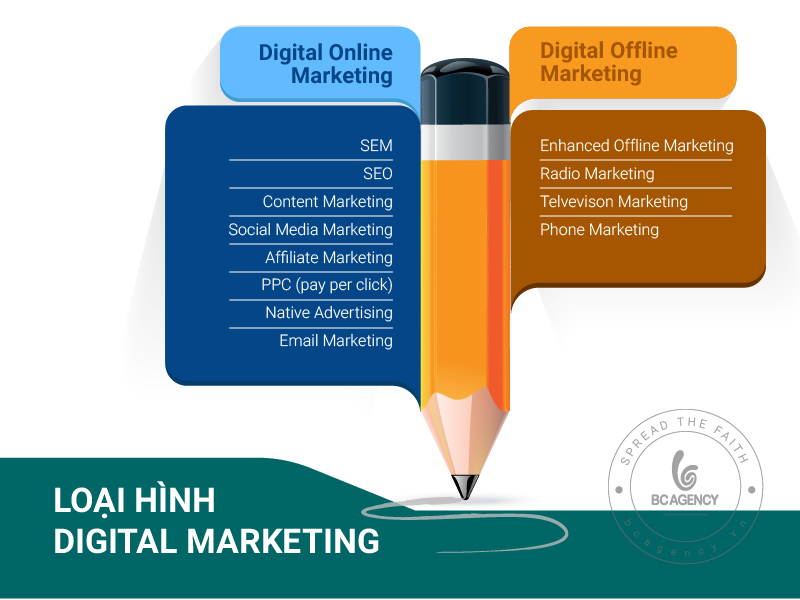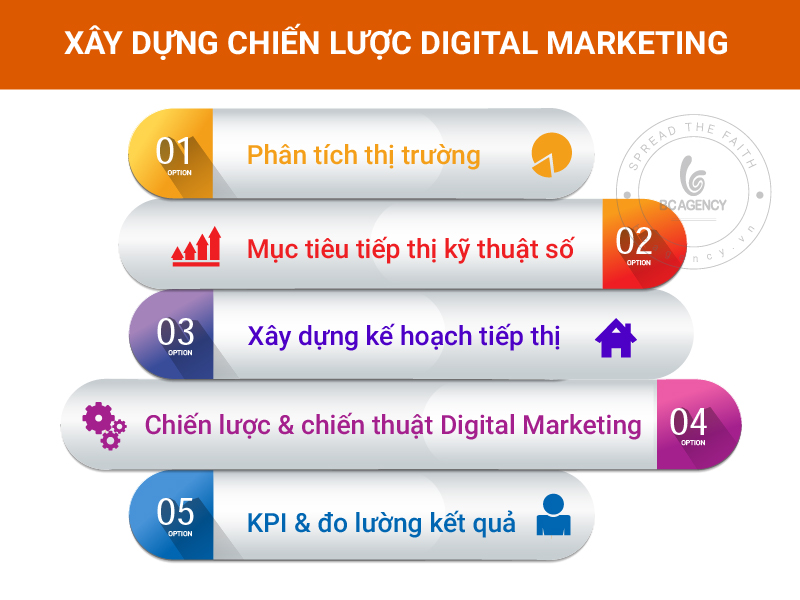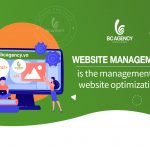
Mục lục
1 – What is Digital Marketing?
Digital Marketing is a form of advertising products, services and brands based on digital platforms to stimulate consumer buying behavior. Focus on using digital media, reaching potential customers, interacting with customers.
2 – What does Digital Marketing include?
Digital Marketing is divided into 2 main channels: Digital Online Marketing using the internet and Digital Offline Marketing based on electronic devices.
SEE MORE:
- Quy tắc bất di bất dịch để sở hữu Tên Thương Hiệu hay
- Tất tần tật về Marketing Căn bản bạn không thể bỏ qua
- Bật mí bí quyết xây dựng BỘ NHẬN DIỆN THƯƠNG HIỆU chuyên nghiệp

Digital Online Marketing
Digital Online Marketing includes 8 types: SEO (Search engine optimization), SEM (Search engine marketing), content marketing, Social Media Marketing, Affiliate Marketing, Pay-per-click (PPC), Native Advertising.
SEM
Search engine marketing aims to increase the visibility of a Website on search engine results pages through optimization and advertising. The main goal is to promote your Website to a wide range of potential customers, increase conversion rates… Work includes: SEO, paid advertising.
SEO
Search engine optimization, help users have the best experience on the website. SEO is responsible for improving the position of the website, good user experience and friendly with Google.
Content Marketing
Create content, publish, transmit content to users on digital platforms. Content Marketing helps attract attention, reach and drive customer buying behavior. Objective: expand customers, increase online sales. What’s more, good content marketing increases brand awareness with customers. Requires a thorough and professional investment in content.
Social Media Marketing
To promote products and services, Social Media Marketing uses social media platforms such as: Facebook, Zalo, Ticktok… Each platform has its own characteristics that require you to provide appropriate content to be effective. fruit.
Affiliate Marketing
Affiliate marketing promotes products and services through online promotion channels. Like Fanpage, Blog, Group… based on CPA (Cost Per Action) advertising fee model.
Pay – per – click (PPC)
To advertise products that advertisers pay per click. Set of keywords that customers often search for, PCC allows bidding for ad placement in search engine sponsored links.Ad position is based on 6 factors: price, ranking threshold ads, ad quality, landing pages, search context.
Native Advertising
Native ads with paid content. Content provided needs to match the look, function and up naturally.
Email Marketing
Through email to send information, develop relationships with potential customers. Convert potential customers into consumers of your products and increase sales.
Digital Offline Marketing
Digital Offline Marketing includes 4 types: Enhanced Offline Marketing, Rido Marketing, Television Marketing, Phone Marketing.
Enhanced Offline Marketing
Is a form of offline Marketing suitable for electronic devices. With 3 popular types: digital products, electronic billboards, product samples.
Radio Marketing
In the period before television was not developed, Radio was a popular and effective communication channel. In the new era, however, radio was replaced by television advertising.
Telvevison Marketing
Digital marketing on TV has existed and developed for more than half a century, and it is still effective every day. Because of the daily habits of most of the presenters, they still use the TV for many hours. But not every unit or product chooses to invest in this type of advertising because of the high cost.
Phone Marketing
The most optimal advertising for businesses: high efficiency, low cost, reaching a large number of customers. Your business can market through cold calling (happy birthday, gifts, discounts, loyal customers…)
3 – Factors affecting digital marketing

Client
Every product/service is ultimately the customer. Therefore, in order to sell products with good sales, it is necessary to understand consumers. You need to analyze and collect data to be able to evaluate customer behavior. From there, come up with a suitable marketing strategy.
Communication
Each platform has different ways and tools to deliver advertising content to reach customers. Depending on each product to choose the right digital marketing platform: Social Media, Mobile, Website…
Technology
Technology is considered a sharp weapon for successful business. Good products, good strategies need to choose the right technology. Because it determines your success.
Quality content
Consumers are extremely smart in evaluating product quality as well as advertising quality. Therefore, instead of producing objectionable, excessive content, you should invest in unique, novel, and attractive content through text, videos, images…
Cost
When you set foot in digital marketing, you need to spend the relative cost of promoting products to customers. For small businesses should use the right marketing channel, hitting the target audience directly.
Customer interaction
If you have a good customer experience, you can increase sales for your business. Require businesses to have analysis, evaluation, and understanding of their customers. This will save you considerable time and money.
4 – Digital Marketing Strategy
Develop a digital marketing strategy to help businesses measure results, collect data, execute, and maximize to reduce costs for businesses and increase sales.
5 steps to build a marketing strategy

Market analysis
To make an effective marketing strategy, you need to analyze the market: the products your business offers, market needs, customer behavior with the product. Market analysis helps you see the strengths – weaknesses, opportunities – threats of the business.
Set digital marketing goals
After analyzing the market, evaluating potential customers, the company’s strengths to set specific goals. Target requirements should be detailed and specific based on the principle: specific, measurable, achievable within a certain time.
Build a marketing plan
Once you have identified your short-term goals and long-term goals, you need to develop a plan to achieve those goals. Understand your customers, to set out specific digital marketing methods for each segment.
- Customer positioning
Identify the customer segment and choose the appropriate advertising method to reach the best source of potential customers with the lowest cost. Create difference, value to drive buying behavior of customers choosing you, not competitors’ products. The channel you choose for digital marketing needs to match the product: Facebook, Blog, Email…
- Content strategy
Content attracts customers, segmenting brands based on customer behavior assessment data. Incorporate a specific media plan for each channel. Implement a specific strategy:
+ Keyword research: The selected keywords need to be relevant to the products and services that the business provides. But make sure customers search for products through those keywords. When you choose the right keywords, deploying a set of keywords helps improve the SEO position of the company, the product.
+ Content scheduling: Timing is the key to the success or failure of the strategy. You need to determine the time to implement the strategy, posting topics, keywords, content, promotions, minigames …
+ Post: To spread the content in the community you need to share the article on social networking sites. That way, you can reach your customers as well as PR about your business.
Digital Marketing Strategy & Tactics
Implement strategies through different marketing channels: email, facebook, website, paid media advertising… so that the product can reach potential customers. There are many channels to choose from, but you should choose which one automates your marketing campaigns.
KPIs & measuring results
The digital strategy has been outlined in detail, what are you waiting for, do not start implementing. The success of the strategy depends on the results. KPIs become an important milestone to optimize performance and costs for a successful Digital Marketing strategy.
5 – Advantages of Digital Marketing
Advantages of Digital Marketing will help you make the most of marketing tools to improve business efficiency.
MAYBE YOU ARE INTERESTED:

Reach potential customers
Digital Marketing makes it easy for businesses to reach potential customers anytime, anywhere. Customers can experience services and products through images, videos, etc. Enterprises can easily evaluate and analyze customer behavior, segments, occupations, age groups, etc. to come up with appropriate strategies. .
Increased flexibility
Through statistics, businesses can make statistics about the effectiveness of advertising and digital marketing. To adjust strategy, approach, content to reach customers.
Optimal cost savings
Tools in Digital Marketing help save costs, reach customers faster than traditional advertising. Businesses do not have to pay fees for premises, maintenance, signs, letters, leaflets…
Measure effectiveness
The statistics will give you accurate advertising effectiveness, your brand reaches the customer source. Assess customer behavior, what channel the customer comes from, time to find information, user-friendly useful content, etc.
6 – Digital Marketing Support Tools
Tools to support market analysis
Before embarking on a product or service business, your business needs to research the market, potential customers, competitors to strategize accordingly.
Website Traffic: The location of the website depends mainly on the traffic of customers. Therefore, the traffic check tool helps you with Traffic status, specific traffic sources.
Advertising Research Tool
Research business brands running ads on channels: Display, Ad Network, image, location, advertising effectiveness…
Mobile application
Mobile applications are an effective assistant to help support the management and implementation of effective digital marketing, easily control and evaluate digital campaigns quickly. You can use tools like: Google Analytics, Facebook Pages Manager, Adword, Hootsuite…
Tools to support Social Marketing
Social networks are currently one of the effective communication and advertising channels to reach potential customers. Social Marketing support tools help manage social networking sites synchronously and professionally. You will not lose time in terms of advertising, content preparation, PR, Branding.



